You Bet Your Garden Guide to Growing Great Tomatoes, Second Edition. Mike McGrath
it swim better. (Colin Clive played Dr. Frankenstein—It’s alive! Alive! Hahahaha!—in the original Boris Karloff movies. Sadly, his tomato preferences are unknown.)
OPEN-POLLINATED OR HYBRID: SCIENCE TIME!
Essentially, the difference here is that if you save seeds from the fruit of an open-pollinated variety (such as Brandywine) and plant those seeds the following year, those seeds will grow you the same type of plant with the same kind of fruit (in this case, big tasty Brandywines).
Hybrids are the product of a deliberate mating of two different varieties in order to combine two desirable characteristics—like, for instance, to get some improved disease resistance into a very tasty, but disease-prone, variety of tomato. The process of creating hybrid seed is fairly complex and very labor-intensive. Basically, you force the flowers of two different, carefully chosen plants to have sex with each other, then protect the resulting pollinated flowers from any outside interference, like bees or wind (usually by covering the newly-pollinated flowers with paper bags). The seeds taken from the fruit that results will produce offspring that are different from either of the parents (like those bratty kids of yours).
The growers and sellers of hybrid seeds have to do this fresh each season—combining the pollen of those same two different varieties every year to create (actually, re-create) the hybrid variety. If you grow a hybrid tomato from seed or started plants, you will get the hybrid plant and fruit, with all of the traits the hybridization was designed to achieve. But if you save the seeds from some of your hybrid tomatoes and plant them the following season, you will not get those same improved plants or fruit. You will get tomato plants of some kind, but they might not be very good ones.
By law, hybrid plants and seeds must be identified by the word ”hybrid” or the term “f1.”
Some hard-line organic folks oppose hybrids on the grounds that they’re not “natural” plants, but there’s nothing diabolical—or even bad—about the process, and it has nothing to do with gene-jerking around. Professionals and talented amateurs have been hybridizing plants for centuries. (Heck—it evens happens out in nature, when frisky bees get promiscuous with different plants in the same genus.) I don’t personally have a problem with hybrid varieties and have grown many hybrids in my own garden. And some folks—in challenging climates and/or areas with extreme disease pressures, for instance—can really use the specialized traits of some hybrids as insurance against the awful possibility of a—sob—tomato-free summer.
And most of the varieties that have been proven to be resistant to specific diseases and pests are hybrids. So go ahead and grow a few if you like—just don’t save the seeds to start next year’s crop.
Now, let’s move on to some of your best choices. Organized by type (beefsteak, paster, etc.).
ONE MORE DEFINITION: HEIRLOOMS!
“Heirloom” tomatoes are at the root of tomato gardening. The best definition of an heirloom variety is a tomato that was once available commercially (in, say, a 1910 or 1911 seed catalog), but was discontinued, became unavailable in the seed trade, and only survives today thanks to dedicated home gardeners. These enthusiasts loved the specific variety in question, and saved some seeds from their best tomatoes season after season so they could continue to grow them, often because they were unique in some way: flavor, color (some wild ones), size, disease resistance, productivity, etc. By definition, therefore, all heirlooms are open-pollinated varieties. Thanks to a renaissance in old-time tomato interest—and the fine work of the individuals and organizations that have tracked down the descendants of the original savers who were still growing out and saving the seeds—many of these great varieties are once again available to all.
This tomato shows the classic “beefsteak” shape, prized by those who want a single tomato slice to cover a sandwich—and maybe hang over the edges a little. It’s available under its generic name (“beefsteak,” which has become more of a type over the years than a single variety name) and also has many more intricately named varieties. All are classic “bragging” tomatoes thanks to their size, flavor, and deep red color.
Top Tomatoes
BEEFSTEAKS AND SLICERS
Arkansas Traveler
| Indeterminate | Open-pollinated | 89 days to maturity |
Comments
Legendary pink heirloom; can handle hot and dry climates; good in South. Proven to be resistant to specific diseases and/or pests.
[bad img format]
Big Beef
| Indeterminate | Hybrid | 73 days to maturity |
Comments
One of the best producers of really huge tomatoes; old-time tomato flavor. Observed to be resistant to specific diseases and/or pests.
Big Boy
| Indeterminate | Open-pollinated | 78 days to maturity |
Comments
Thick-walled, meaty one-pounders (450g).
Big Rainbow
| Indeterminate | Open-pollinated | 100 days to maturity |
Comments
Huge, beautiful, tasty heirloom; red streaks through gold fruit; takes heat well. Proven to be resistant to specific diseases
